Peptide diffusion as a signal for Casparian strip diffusion barrier formation ($)
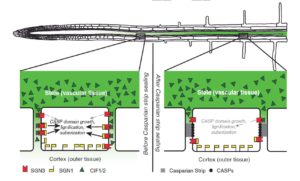 The Casparian strip is a permeability barrier that seals the spaces between root endodermis cells and so prevents bulk-flow uptake of solutes. Previously, a leucine-rich repeat receptor kinase called SCHENGEN3 or GASSHO1 (GSO1/SGN3) was identified as necessary for normal Casparian strip formation. Now, two papers in Science show that the interaction between diffusible peptides and GSO1/SGN3 regulates lignification (hence sealing) of the Casparian strip. Nakayama et al. (10.1126/science.aai9057) identified two genes encoding peptides named CASPARIAN STRIP INTEGRITY FACTORS (CIF1 and CIF2), which they then demonstrated to be ligands for GSO1/SGN3. Doblas et al. (10.1126/science.aaj1562) showed that the mutant schengen2, which has a phenotype similar to sgn3, encodes an enzyme necessary for tyrosine sulfation of the CIF peptides; they further showed that the sgn2 mutant phenotype is complemented by the sulfated CIF peptides. Based on these studies, a “barrier surveillance” model is proposed in which a leaky endodermis permits CIF1 and CIF2 (produced interior to the endodermis) to move outwards and bind to the SGN3 receptor on the outer surface of the endodermis, signaling lignin production to seal the leak.
The Casparian strip is a permeability barrier that seals the spaces between root endodermis cells and so prevents bulk-flow uptake of solutes. Previously, a leucine-rich repeat receptor kinase called SCHENGEN3 or GASSHO1 (GSO1/SGN3) was identified as necessary for normal Casparian strip formation. Now, two papers in Science show that the interaction between diffusible peptides and GSO1/SGN3 regulates lignification (hence sealing) of the Casparian strip. Nakayama et al. (10.1126/science.aai9057) identified two genes encoding peptides named CASPARIAN STRIP INTEGRITY FACTORS (CIF1 and CIF2), which they then demonstrated to be ligands for GSO1/SGN3. Doblas et al. (10.1126/science.aaj1562) showed that the mutant schengen2, which has a phenotype similar to sgn3, encodes an enzyme necessary for tyrosine sulfation of the CIF peptides; they further showed that the sgn2 mutant phenotype is complemented by the sulfated CIF peptides. Based on these studies, a “barrier surveillance” model is proposed in which a leaky endodermis permits CIF1 and CIF2 (produced interior to the endodermis) to move outwards and bind to the SGN3 receptor on the outer surface of the endodermis, signaling lignin production to seal the leak.


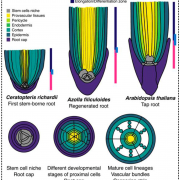

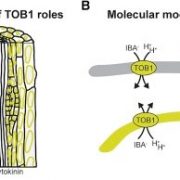
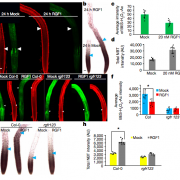
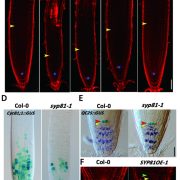
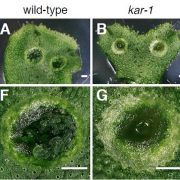


Leave a Reply
Want to join the discussion?Feel free to contribute!